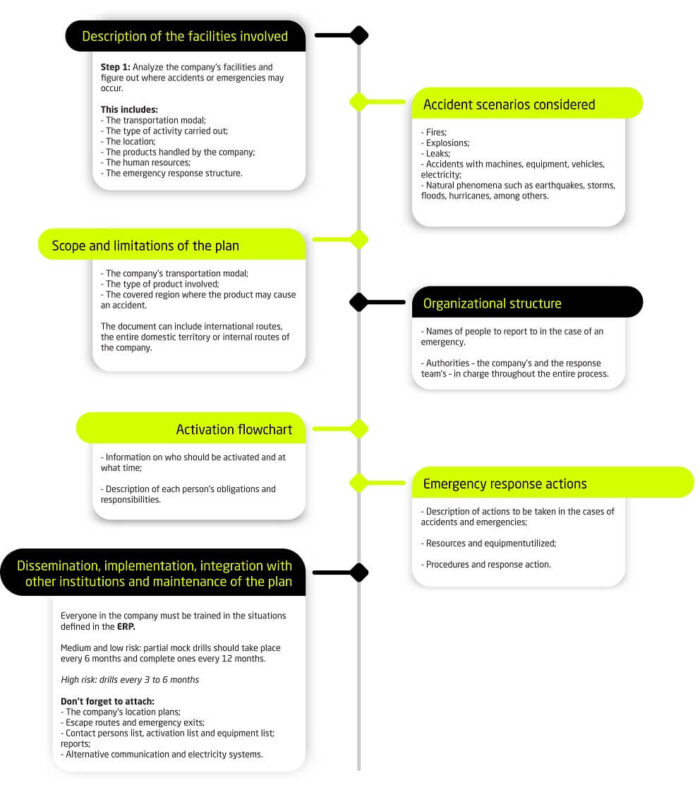
By Equipe de Redação
Posted in April 14, 2021

When such an accident occurs, the faster the response time, the less the impacts on the company’s property, the population and the environment.
However, for that to happen it is first necessary to prepare an Emergency Response Plan.
What is the Emergency Response Plan (ERP)?
The ERP is a plan designed to provide guidelines, strategies, information and data that will allow the definition of logical, technical and administrative procedures to be followed in cases of accidents and emergencies.
What are its main characteristics?
Every company that performs any activity with a potential for accidents must prepare the ERP, which must indicate whose responsibility is it for responding to an emergency if it should occur.
For instance, a company “XYZ” transports chemicals to and from every corner of the country. Therefore, it must have a plan for the event of an accident happening with any vehicle of its fleet, regardless of its location in the country.
As the document necessarily has to indicate the company contracted to respond to the emergency, in our example Ambipar would be in charge of it.
The company “XYZ” must also list the names of all those that would be involved in the case of emergencies, as well as their duties and responsibilities. This procedure speeds up the whole process considerably.
It is important to remember that visitors or third parties, even not having any direct relationship with the company, must also be included in the ERP. Thus, it is possible to predict who will assist them, as well as to provide training for that purpose.
Besides naming the parties involved, the plan must also include the resources – human and material – available to be used by the contracted company – in this case, Ambipar – in the response actions. Such resources must be compatible with the possible accidents to be responded to.
Finally, the whole structure available to resolve an emergency in the modals in which the company operates must be described as well. For example, for the company “XYZ”, which operates all over Brazil roads carrying chemicals, any existing structure to respond to emergencies in the land modal(s) utilized must be detailed in the plan.
What is the structure of an ERP?
No two ERPs are alike. Thus, each company will have a personalized document, according to its type, products, location and area covered, among other factors.
On the other hand, there is a general structure to be observed when it comes to preparing the plan.

1. Description of the facilities involved
To define the actions to be taken during an emergency response, the first step is to analyze the company’s facilities and figure out where accidents may occur.
This includes:
2. Accident scenarios considered
Along with the company’s diagnosis, an analysis of possible accident scenarios – in line with the risks inherent in its activities – will also be carried out.
These scenarios will vary according to the corresponding modal(s) employed by the company as well as its field of activity. They can involve fires, explosions and leaks, accidents with machines, equipment, vehicles or electricity, and even natural phenomena such as earthquakes, storms, floods and hurricanes, among others.
3. Scope and limitations of the plan
The scope and limitations of an ERP must be clearly defined. This includes the modal(s), the type(s) of product and the region(s) covered by the plan. The definition of these points is in charge of the company that needs the document, taking into account the characteristics and complexity of the accident scenarios considered.
The region may include international routes, the entire domestic territory, just a couple of regions or even the internal routes of the company. What matters at this stage is to delimit the precise area where the products transported may cause accidents.
In the example given here, the company “XYZ” will define the area covered by its ERP. As it transports chemicals all over Brazil, its ERP must comprise all the routes taken by its fleet in the country. But if, for example, the products are carried throughout Mercosur, the corresponding routes must also be included.
4. Organizational structure
The company has to be mindful of all areas that must be included because, otherwise, the emergency response service will increase in complexity as the actions will have to be defined at the time of the assistance. Not having a service by which it is possible to activate the emergency response team quickly may subject the company to environmental fines, plus the financial impacts that, in the absence of a previously prepared plan, are far higher than if it had been done before.
The organizational structure includes the people who are involved, from the company that needs the plan and from the company that will provide the emergency response services alike.
At this point, who to report to in case of an emergency is defined as well as what authorities are in charge throughout the entire process. For instance, the emergency coordinator and under-coordinator, the brigade leader, the director, the support staff, the medical clinic staff, among others, must be established.
It is important to highlight that the database containing such information must be constantly updated, allowing the emergency response team to be aligned with all processes.
4. Activation flowchart
Having the organizational structure of the ERP been established, the next step is to define the activation order of those involved in the emergency response – and at what time it should occur – as well as their obligations and responsibilities.
5. Response actions to emergencies
This part describes all the actions to be taken in the case of accidents and emergencies that are compatible with the scenarios considered.
Included here are the resources to be used in such actions. For example, vehicles, type of barrier, type of transfer pump, fire hoses and Personal Protective Equipment (PPE), among others. Everything is dimensioned and defined according to the product, the scenario and the region of the country where the emergency may occur.
Besides the resources that will be used, each type of scenario includes the emergency response actions to be taken. So, if activated, the team will already know what to do to resolve the incident.
6. Dissemination, implementation, integration with other institutions and maintenance of the plan
After the preparation of the ERP, the entire company must be trained in the situations that were defined in the plan, including the explanation of each point of its structure.
When accident risk levels range between medium and low, partial mock drills must be performed every 6 months at the most and full drills, every 12 months. For high-risk levels, those times must be curtailed to 3 and 6 months, respectively.
Dissemination should be made to everyone in the company with no exceptions, to make it clear to each one what they should do in the event of an emergency.
Visitors must also be informed about the plan’s existence, whether through videos, brochures or lectures. The ERP must also be spread in onboarding and periodical training, as well as be made available for consultation in emergencies.
Plan maintenance must be carried out annually. However, there are cases in which the plan must be revised in shorter periods. For instance, whenever:
The need for periodical revisions adds to the reasons why the ERP must be prepared by a specialized company with the know-how to ensure that all planned actions are effective to avoid or mitigate damages caused by possible accidents.
Finally, documents such as location and layout plans, escape routes and emergency exits, contact persons list, activation list, equipment list, reports, and alternative communication and electrical energy systems must also be attached to the ERP.
How important is the ERP for a company?
As it consists of previously defined guidelines on the procedures to be followed as well as the persons who are in charge of them in an emergency, the plan streamlines the entire response process from its activation to the displacement of those in charge and the actions to be taken in the field.
As it also provides for training and mock drills, it allows the procedures to be put to the test, preparing everyone in the company to act correctly in an emergency.
Response time is then minimized, and failures, errors, duplicate actions and trampling are avoided, because the people involved will already know the information flow, who should be activated and what should be done.
Therefore, the ERP ensures quick and efficient action, helping preserve lives, reduce possible harm to the environment and prevent property losses, thus demonstrating that accident prevention will always be the best answer when it comes to emergencies.
What are the impacts of not having an ERP?
Not having a prepared ERP means that the company has no planning and does not have a response structure and that no one in the company has been trained for emergencies.
This results in several problems. One of them is the “conflicts”, meaning that no one knows who should be activated and at what time nor what each one will be able to do in the event of an incident.
Due to these conflicts, precious time is wasted, the emergency becomes more difficult to resolve and the impacts get increasingly worse every minute nothing is done.
In the example of the company “XYZ”, in the event of a leak in the chemicals it carries, who should be notified first when the leak is discovered, if there is no plan? What should the driver do and who should he contact? Who should be called in to resolve the problem?
Nevertheless, Ambipar can be activated in those cases when there is no emergency contract signed with us or ERP prepared by us. In this situation, the company needing assistance can get in touch with Ambipar, and the emergency will be immediately passed on to CECOE, our 24/7 Emergency Control and Management call center .
In such cases, it is enough for the company to identify itself as a non-client in need of emergency response assistance. The CECOE team will request all information and make an emergency response team available immediately to head to the scene. Once there, the team will identify the scenario, define the equipment to be used and outline the response strategy, and then presents the client – the company is already considered so from the moment it contacts the CECOE with all the required actions and overall costs . The client may or not accept the services as proposed. If it does, the team will resolve the issue and the client will pay for all equipment and actions taken in the process. Afterward, the client is passed on to the sales team, which will prepare estimates and offer our services on a contract basis .
One more reason that justifies having an emergency response service under contract and an ERP already prepared is the environmental impacts caused by the occurrence. If chemicals leak, for example, until specialized teams arrive to handle the situation, the accident keeps impacting the surrounding environment and even nearby communities – depending on the region where it happens. Therefore, it’s never too much to stress the importance of having the response actions defined in the document to minimize the problems.
For this reason, the consequences of not having an ERP ready can be very serious, with costs eventually reaching beyond the company’s equity, and taking the proportions of even bringing about environmental problems, affecting the communities surrounding the emergency and causing victims.
Who must be in charge of the ERP?
Any type of company in which accidents are likely to happen must prepare its ERP, which must necessarily name the company that will respond to the emergency if it should occur.
Ambipar specializes in emergencies involving health, the environment and property, always riding the leading edge of environmental management . This is only possible because it owns more than 150 operating bases employing vehicles equipped with advanced on-board technology, operating in 16 countries in South America, North America, Europe, Africa and Antarctica.
Also, Ambipar has an Emergency Control and Management Center (CECOE) certified under the UNE[1]-ISO[2] 22320 standard. It is formed by specialists in crisis management who provide decision-makers with strategic information on emergency scenarios and ensure quick and effective communication and logistics of the resources required.
Having Ambipar in a company’s ERP means guaranteeing the fulfillment of the entire plan structure, providing security whenever necessary, having its resources strategically distributed to different segments and employing technical teams highly trained and qualified under the NFPA[3] 472 and the ABNT[4] NBR[5] 14064 standards, capable of responding quickly to the most varied emergency scenarios, acting with quality and based on defined protocols.
Ambipar also has specialist engineers to assist in the preparation of the ERP in line with the client’s needs, thus ensuring a fully effective document for the event of emergencies.
[1] UNE: Spanish Association for Standardization
[2] ISO: International Organization for Standardization
[3] NFPA: National Fire Protection Association
[4] ABNT: Brazilian Technical Standards Association
[5] NBR: Brazilian Regulatory Standard


Our business analysts are ready to help your company with the best environment solutions.